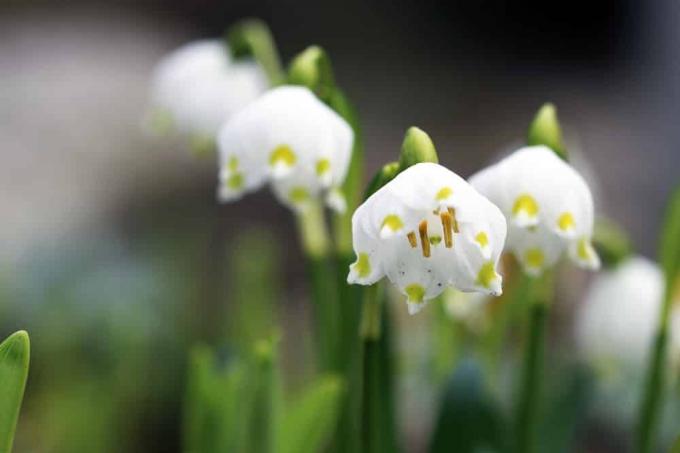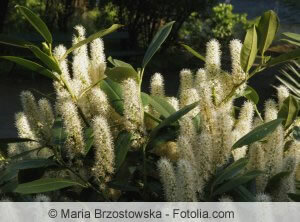

Table of contents
- ingredients
- Effect
- danger to humans
- No pet food
- Danger from crossing
The bowl flower partly contains ingredients that are not completely harmless, which is why it may only be used in small quantities. However, it is far more dangerous to confuse them with poisonous relatives.
ingredients
The native species here is, among others, the meadow primrose (Primula veris). It is protected in some areas and may only be picked in small quantities, if at all. Plants from specialist shops therefore have a lot in their garden, where their use is of course permitted. Due to its ingredients, it is a traditional medicinal plant, which, however, can also be dangerous in high doses.
The ingredients of Primula veris:
- saponins
- flavonoids
- Volatile oil
- triterpene saponins
- sugars
A notice:
The content of ingredients varies depending on the plant part. The root in particular contains a large amount of triterpene saponins.
Effect
The triterpene saponins are used in folk medicine to irritate the gastric mucosa, which in turn is supposed to stimulate the bronchial mucosa to produce mucus. The meadow primrose is advertised as a cold remedy for bronchial infections, but is not entirely without side effects.
Irritation of the gastric mucosa in particular can lead to the following side effects in humans:
- stomach pain
- nausea
- Diarrhea
- Overstimulation of the mucous membranes
- dermatitis
In rare cases, it can even lead to vomiting and significant allergic skin reactions. The reactions of the skin show up even if affected persons have only used extracts from the plants internally.
danger to humans
For healthy adults, the bowl flower is safe to eat in small quantities. The herb is used for this and the root of the cowslip is a traditional medicinal plant in folk medicine. In children or However, you should avoid the bowl flower for small children. For example, coughing up the mucus can be problematic without additional help and the stomach can become very irritated.
Use of the cowslip:
- Blossoms: edible decoration, colorant, tea
- Leaves: cut into small pieces for salads
- Root: Tea for bronchial problems
Suitable as a coloring plant Primula veris only to a limited extent, because in order to obtain an appreciable coloration, larger quantities of flowers must be present. Usually, however, only small quantities are available, which are enough to dye a few Easter eggs. However, you can use the flowers as a decorative drug in teas, with the pleasant side effect that they even have an effect, albeit a much weaker one, than the roots.
A notice:
Severe poisoning by cowslips in adults or children is not known, which is why the meadow primrose is considered edible. Symptoms such as stomach problems usually go away on their own as soon as cowslip is no longer consumed.
The cowslip can be problematic for people who have stomach problems. This group of people should completely refrain from using the plant in any form.
No pet food
Dogs or cats rarely come into contact with significant amounts of cowslip herb. Even if they nibble on the plant or eat whole leaves, they do not endanger themselves. It looks a little different when large amounts of small animals such as rabbits or guinea pigs are fed. The meadow primrose alongside other cowslips such as the widespread one Primula elatior often end up in a fresh bouquet of food for the small animals and often even on purpose, since the plants appear in spring. Since most of the questionable ingredients are in the root, a few leaves are not dangerous for the animals, but larger amounts can cause severe poisoning.

The symptoms are comparable to those in humans, but are often recognized too late. So that house or However, if small animals show symptoms, they must have consumed large amounts.
Danger from crossing
Primroses are among popular plants, of which exotic species such as the Primula obconica be cultivated as a houseplant. For example, exotic species can cause an allergy, which manifests itself in the form of itching on contact. Primroses are popular plants for a reason, as they are easy to grow. It is also easy to create new breeds by crossing. Crossbreeding does not only happen during breeding, but now also between cultivated and wild forms.
The increasing number of cultivated varieties increases the risk of wild forms crossing with cultivated varieties that have a higher content of problematic ingredients. This often results in plants that cannot be clearly identified, since they have neither clear characteristics of the wild form nor the cultivated form. You should therefore refrain from using primroses that cannot be clearly identified.
Sources:
https://praxistipps.focus.de/primeln-giftig-fuer-mensch-und-haustier-einfach-erklaert_116519
https://botanikus.de/informatives/giftpflanzen/alle-giftpflanzen/becher-primel/
https://hundeinfoportal.de/hundewissen/hundegesundheit/vergiftungen-hund/fuer-hunde-giftige-pflanzen/
https://www.katzen-leben.de/katzen-pflanzen/sind-primeln-fuer-katzen-giftig/
https://de.wikipedia.org/wiki/Echte_Schl%C3%BCsselblume
 Home editorial office
Home editorial office
Learn more about spring gardening tips

Clean pool in spring | 5 tips for pool cleaning & commissioning
As soon as it gets warmer outside again in spring, it's time to prepare the pool in the garden for use. This usually means: First of all, it has to be thoroughly cleaned. Here are helpful tips for cleaning and commissioning.

Pressing and drying flowers: instructions for roses and edelweiss
Rose and edelweiss are two amazing flowers from Mother Nature's workshop. Her unique beauty simply has to be admired. They come fresh into the house, but only last a short time. Properly dried, on the other hand, they can stay with us longer.

Preparing the vegetable bed: 7 tips for soil in the garden bed | Garden
Preparing the vegetable beds and soil is extremely important for a successful harvest. This step should be done before sowing in spring. The first measures are already necessary at the end of winter so that the soil is sufficiently prepared.

18 spring flowers sorted by color: list with names
Spring brings more light and warmth and the most beautiful flowers sprout. Nature satisfies our longing for colour. When the sky is gray again outside, a glance at the colorful spring flowers is enough to put you in a good mood.

Types of flowers from A-Z: the encyclopedia with 50 types of flowers
Flowers adorn gardens and balconies with their diverse flower shapes and their impressive blaze of colour. The lexicon of the 50 types of flowers tells you which flowers are suitable for the shade and which need a lot of sun in order to bloom colorfully and plentifully. You will also find flowers for every season here.

Creating flowering hedges - planting plan for flowering hedges
A flowering hedge must be well prepared, because not only the choice of variety is decisive, but also where the plants are positioned. This is recorded in advance in a planting plan, where not only the location, but also the The size that the individual perennials take is listed, which will allow them to develop well later can.



